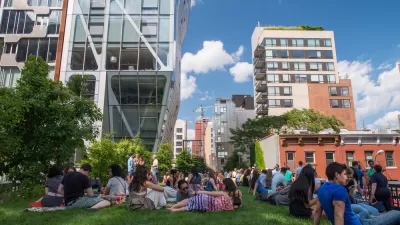A recent art project in Peru utilizes a robotic vehicle to trace a scale outline of a city into the empty desert, raising questions about urbanization in deserts and the formation of cities.
In this interview on We Make Money Not Art artist Rodrigo Derteano explains the project.
"I live and grew up in Lima. About 60% of the city today lies within the desert, most of it grew without any serious urban planning. It's a self-made metropolis, the second largest city built in the desert after Cairo. It grew from 1 million to 8 million people in less than 60 years. There's a lot of problems derived from this development in terms of sustainability and living standards which exacerbate the huge inequality of our society. The desert plays a big role in this regard. People living in desert areas of the city are usually poor and often have to pay more for water than those living in more centric (richer) areas. They also lack proper infrastructure and have much less public places and parks. For a long time, these areas were not considered part of the city by the ruling class and the authorities until they became the majority.
By drawing a gigantic map of a city onto the desert, the project not only seeks to draw attention to this facts, but questions our very concept of city, specially in regards to its environment. Lima is a sort of negation of the desert. Our model and ideal of city is very occidental, and does not adapt very well to its context. The desert is seen a kind of non-place, not a part of our living environment. In this sense, there's a sort of irony in using a robot to draw a city onto the desert, as if it would be drawing it on the surface of Mars (exploring the outer space for the possibility of urban life)."
FULL STORY: Ciudad Nazca, the robot tracing a city in the desert

Maui's Vacation Rental Debate Turns Ugly
Verbal attacks, misinformation campaigns and fistfights plague a high-stakes debate to convert thousands of vacation rentals into long-term housing.

Planetizen Federal Action Tracker
A weekly monitor of how Trump’s orders and actions are impacting planners and planning in America.

In Urban Planning, AI Prompting Could be the New Design Thinking
Creativity has long been key to great urban design. What if we see AI as our new creative partner?

Cal Fire Chatbot Fails to Answer Basic Questions
An AI chatbot designed to provide information about wildfires can’t answer questions about evacuation orders, among other problems.

What Happens if Trump Kills Section 8?
The Trump admin aims to slash federal rental aid by nearly half and shift distribution to states. Experts warn this could spike homelessness and destabilize communities nationwide.

Sean Duffy Targets Rainbow Crosswalks in Road Safety Efforts
Despite evidence that colorful crosswalks actually improve intersection safety — and the lack of almost any crosswalks at all on the nation’s most dangerous arterial roads — U.S. Transportation Secretary Duffy is calling on states to remove them.
Urban Design for Planners 1: Software Tools
This six-course series explores essential urban design concepts using open source software and equips planners with the tools they need to participate fully in the urban design process.
Planning for Universal Design
Learn the tools for implementing Universal Design in planning regulations.
Appalachian Highlands Housing Partners
Gallatin County Department of Planning & Community Development
Heyer Gruel & Associates PA
Mpact (founded as Rail~Volution)
City of Camden Redevelopment Agency
City of Astoria
City of Portland
City of Laramie



























